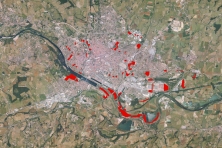Underlying Cultures
Evreux (FR) - Runner up
TEAM DATA
Team Representative: Clémence Aubrée (FR) – architect
Associate: Léna Hinault-Kaiser (FR) – architect
17 rue Paul Féval, 22000 Saint-Brieuc (FR)
+33 688040072 – atelier.calhk@gmail.com
See the complete listing of portraits here
See the site page here

C. Aubrée & L. Hinaukt-Kaiser
INTERVIEW
Click on the images to enlarge
1. How did you form the team for the competition?
We are both young graduates from the Brittany’s School of Architecture. Once graduated, we worked at the Côtes d’Armor Council of Architecture, Urban Planning and the Environment (CAUE 22). This work experience has raised our awareness about urban planning, public spaces, landscape, the simplicity of urban spaces, and the optimal use of resources. It has influenced our site selection and the project we have done.
2. How do you define the main issue of your project, and how did you answer on this session main topic: the place of productive activities within the city?
The city of Evreux has submitted several issues to us. First, the development of the area around the railway station should help to link the upper and the lower part of the city located on both sides of the railways. Moreover, the weakened attractiveness of the city center should be enhanced by the valorisation of the main commercial street turning it into a “productive street”. Before thinking about the connection between the different areas and the city center attractiveness, we first had to focus on the main issue of the city. In Evreux as in many other medium cities, there are too many cars in the urban spaces at the expense of public spaces quality, landscape and natural resources. The oversized road infrastructures create bigger breaks in the city than the local topography. In response to Evreux' issues, we have proposed that the productive activities should be reintegrated within the city through the development of a landscape project where current road infrastructures are dominating.
3. How did this issue and the questions raised by the site mutation meet?
The city of Evreux considered the land around the railway station like an opportunity to connect the upper and the lower part of the town. Keeping in mind the perimeter of the Europan site, we decided to have a broader look at the whole territory in order to achieve a project in line with the ebroïcien territory made of urban valleys, once industrialized, hills and agricultural plateaux. The Underlying Cultures project answers Evreux issues with agricultural production and environmental matters as a key to value landscape and public spaces. Thus the station area located along the South hill, will reinforce and add value to the landscape with various agricultural activities like the tree crop. The lower part of the city located in the valley, which is the historic part, will be densified with mixed planning of housing, equipments and commercial activities. The upper part of the city spread on the currently waterproofed plateaux, will be protected from new urbanisation to address the porous nature of the city borders with new agricultural activities respectful of the environment.
4. Have you treated this issue previously? What were the reference projects that inspired yours?
We had not directly handled the theme of productive city in our projects. However during our previous experiences we have worked regularly on contact with similar cities facing the same issues as Evreux. The urbanisation of these cities is related to motorized journeys. The peripheries have strongly grown at the expense of city center attractiveness and quality of public places. Various references have inspired our thoughts and oriented the project Underlying Cultures. The contemporary agricultural landscapes conceived by the agency Fabriques, stage both productive and qualitative environment-friendly spaces. So they show us urban habits can be associated with spaces of agricultural production. Olivier Razomon's book « Comment la France a tué ses villes » is the reflection of what we observe in our projects and in our everyday life. By several examples the journalist presents the phenomenon of devitalization which affects the centers of mid-sized cities and questions the choices of developments of our territories.

5. Urban-architectural projects like the ones in Europan can only be implemented together with the actors through a negotiated process and in time. How did you consider this issue in your project?
Europan allowed us to present to the city a project with a process and not a completed design to hand. So the ideas introduced during the competition now need to be discussed and enriched in contact with the city, the local services and the present potential project leaders of the territory. Because of these issues, the city of Evreux seemed to us to be the ideal site to propose a strategy of large-scale arrangement. With the next discussions, we can choose some sites where this can be worked on on a smaller scale.
6. Is it the first time you have been awarded a prize at Europan? How could this help you in your professional career?
It's our first participation in Europan. This work allowed us to develop and to put on paper our common ideas, a shared vision about the urban space and its planning. We hope that a follow-up of Europan will allow us to work in association with a community on a project as fascinating as the productive city.





